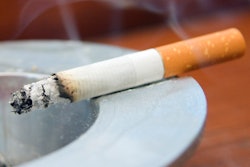
HONOLULU - Is CT lung cancer screening less effective during flu season? Probably not, but screening eligible smokers for respiratory illnesses such as the flu before ordering the exam sharply reduced the need for downstream testing, according to a presentation at the American Roentgen Ray Society (ARRS) annual meeting.
The high false-positive rate associated with the National Lung Screening Trial (NLST) and similar population-based screening studies has been on the decline in recent years due to improvements in lung cancer detection techniques and updates to the American College of Radiology (ACR) Lung-RADS nodule reporting tool. Nevertheless, various groups have sought to minimize unnecessary downstream testing after CT lung screening as much as possible.
To that end, researchers from Stony Brook University Hospital in New York developed a method to help reduce the need for downstream testing during periods marked by particularly high false-positive CT lung screening exams. One of these periods is flu season. The intervention involved finding out which participants had a recent respiratory illness, including the flu, before their scheduled CT lung screening exam and then rescheduling those exams for a later date.
"We found that a simple intervention made by our schedulers could help avoid downstream testing that incurs radiation burden, unnecessary interventions, and increased cost," presenter Dr. Syed Hussaini told session attendees.
Seasonal CT lung screening
During the 2015-2016 flu season, Hussaini and colleagues noticed that a markedly high number of participants in their CT lung screening program received a Lung-RADS 3 or 4 classification and thus required further testing. However, follow-up CT or PET/CT scans performed three or six months after the initial screen revealed that the nodules identified on the vast majority of these repeat exams had completely resolved without treatment.
This trend gave the group cause to suspect that many of these individuals had an active infection or respiratory illness prior to the exam, which resulted in inflamed nodules showing on the CT scans -- inadvertently increasing the number of false-positive screening exams.
"Even in the National Lung Screening Trial, there was a reported false-positive rate of 27% in the first two rounds but only 16.8% in the third round," Hussaini said. "Again, we were wondering if some of these inflammatory lesions that were seen on CT lung cancer screening [scans] resulted in an increased rate of false positives."
To validate their supposition, the researchers reviewed data from 765 individuals who underwent CT lung screening exams at their hospital between 2015 and 2017. They divided the data into two categories: CT exams acquired during flu season, as defined by the U.S. Centers for Disease Control and Prevention (CDC), and exams acquired outside of flu season.
After analyzing the information, Hussaini and colleagues discovered no statistically significant difference in the rates of short-term follow-up imaging between individuals who underwent CT lung screening during flu season and those who were screened outside of flu season. The rate was 4.6 percentage points higher during the 2015-2016 flu season than it was outside of flu season, but 2.6 percentage points lower during the 2016-2017 flu season, when screening exams were rescheduled.
Proof in the pudding
However, the researchers did identify a statistically significant decrease in downstream testing between the two different flu seasons. To be precise, the proportion of individuals who required additional testing fell by 5.9 percentage points from the first flu season (16.5%) to the second (10.6%).
| Effect of CT lung cancer screening rescheduling on downstream testing | ||
| 2015-2016 flu season (preintervention) | 2016-2017 flu season (postintervention) | |
| Rate of downstream testing for CT lung screening exams | 16.5% | 10.6% |
Furthermore, the proportion of follow-up CT scans with lesions that had completely resolved and turned out to be false positives was nearly 5% lower in the 2016-2017 flu season than it was in the preceding flu season.
The underlying force driving this trend reversal was the addition of a simple question to the prescreening protocol. Starting with the 2016-2017 flu season, schedulers of the CT lung screening program began asking eligible participants if they had a recent respiratory illness or active lung condition such as bronchitis. For those who answered affirmatively, the scheduler postponed the screening exam by six to eight weeks to give the patient time to seek treatment or recover from the illness.
When asked how these findings have affected recent hospital practice, Hussaini explained that the hospital's CT lung screening program has upheld the intervention and has every intention of continuing to do so. "The proof is in the pudding," he said. "We have seen how these results have helped reduce downstream testing, and it would be hard to discontinue it now."




















